Australia & Singapore Health Workforce Planning - Analytic Report
VerifiedAdded on 2023/06/11
|26
|4742
|463
Report
AI Summary
This report provides an analytical comparison of the national health workforce plans of Australia and Singapore, focusing on their approaches to healthcare workforce planning. It includes an environmental scan of the health workforce in both countries, highlighting key issues such as the aging workforce, growth in demand, and staff attraction and retention. The report presents a SWOT analysis for both Australia and Singapore, detailing their strengths, weaknesses, opportunities, and threats in the health sector. It also examines data profiles for both countries, comparing aspects such as physician density, nursing and midwifery density, and dentistry personnel density. The report identifies critical issues to be addressed in each country and discusses the implementation of WHO priorities based on ten recommendations, aiming to improve the health workforce and ensure quality healthcare services.
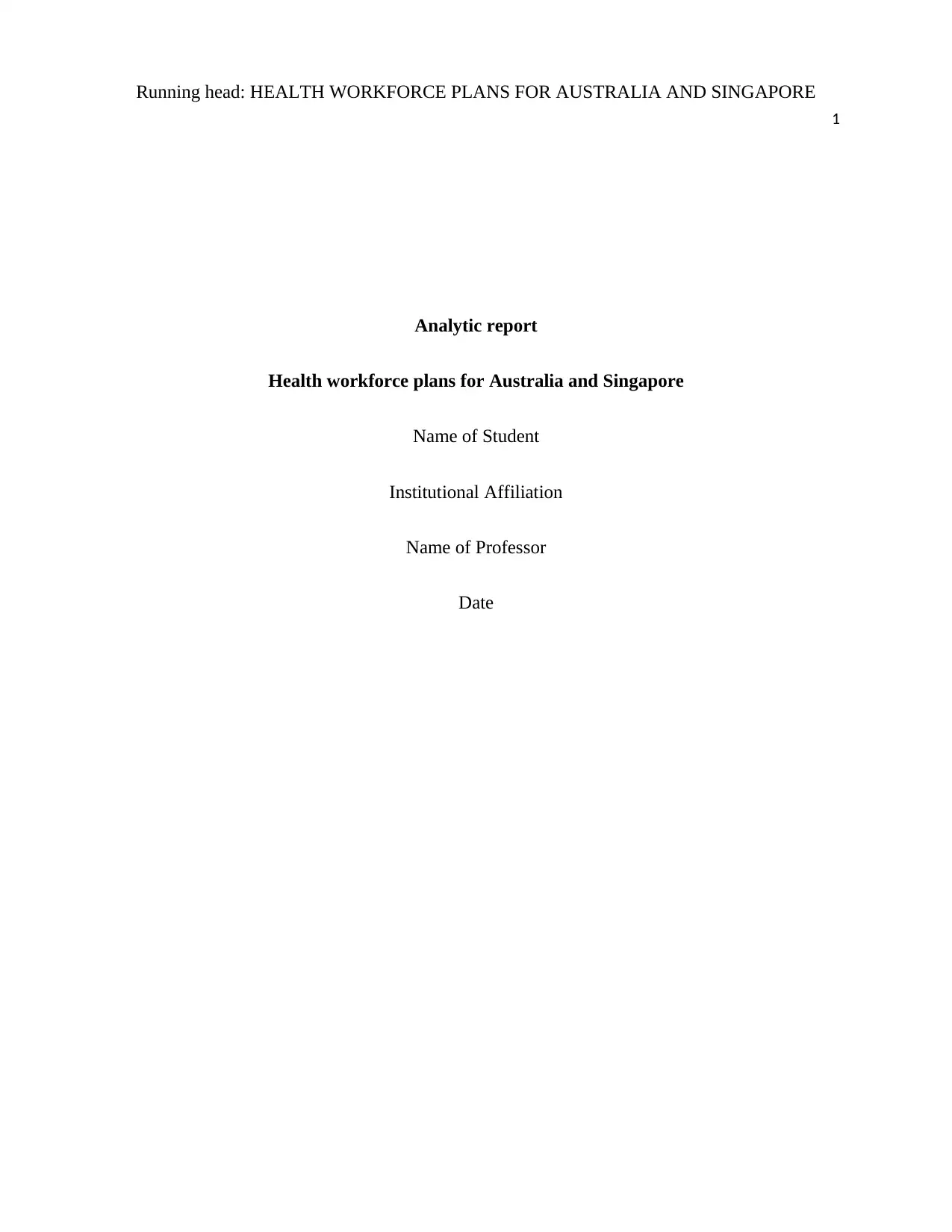
Running head: HEALTH WORKFORCE PLANS FOR AUSTRALIA AND SINGAPORE
1
Analytic report
Health workforce plans for Australia and Singapore
Name of Student
Institutional Affiliation
Name of Professor
Date
1
Analytic report
Health workforce plans for Australia and Singapore
Name of Student
Institutional Affiliation
Name of Professor
Date
Paraphrase This Document
Need a fresh take? Get an instant paraphrase of this document with our AI Paraphraser
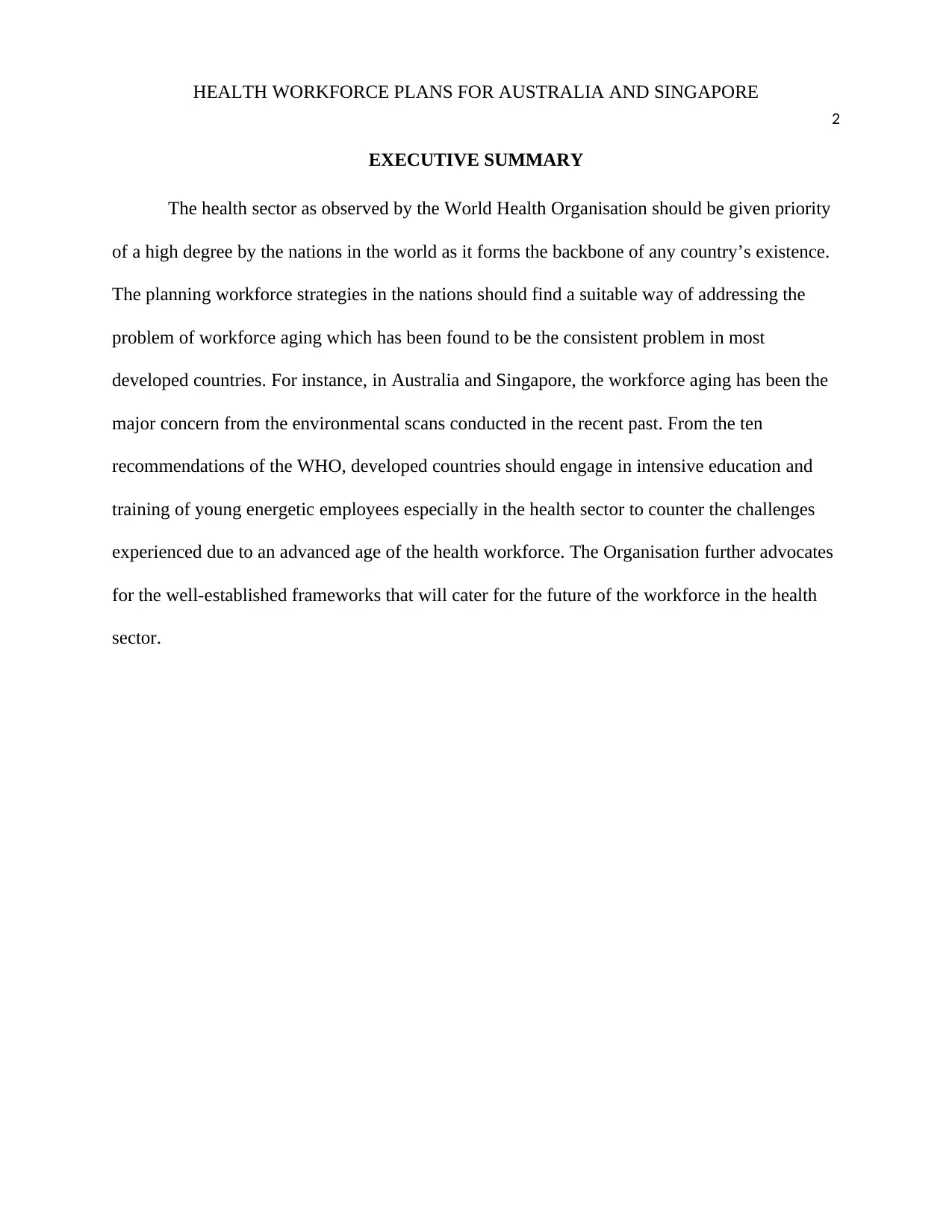
HEALTH WORKFORCE PLANS FOR AUSTRALIA AND SINGAPORE
2
EXECUTIVE SUMMARY
The health sector as observed by the World Health Organisation should be given priority
of a high degree by the nations in the world as it forms the backbone of any country’s existence.
The planning workforce strategies in the nations should find a suitable way of addressing the
problem of workforce aging which has been found to be the consistent problem in most
developed countries. For instance, in Australia and Singapore, the workforce aging has been the
major concern from the environmental scans conducted in the recent past. From the ten
recommendations of the WHO, developed countries should engage in intensive education and
training of young energetic employees especially in the health sector to counter the challenges
experienced due to an advanced age of the health workforce. The Organisation further advocates
for the well-established frameworks that will cater for the future of the workforce in the health
sector.
2
EXECUTIVE SUMMARY
The health sector as observed by the World Health Organisation should be given priority
of a high degree by the nations in the world as it forms the backbone of any country’s existence.
The planning workforce strategies in the nations should find a suitable way of addressing the
problem of workforce aging which has been found to be the consistent problem in most
developed countries. For instance, in Australia and Singapore, the workforce aging has been the
major concern from the environmental scans conducted in the recent past. From the ten
recommendations of the WHO, developed countries should engage in intensive education and
training of young energetic employees especially in the health sector to counter the challenges
experienced due to an advanced age of the health workforce. The Organisation further advocates
for the well-established frameworks that will cater for the future of the workforce in the health
sector.
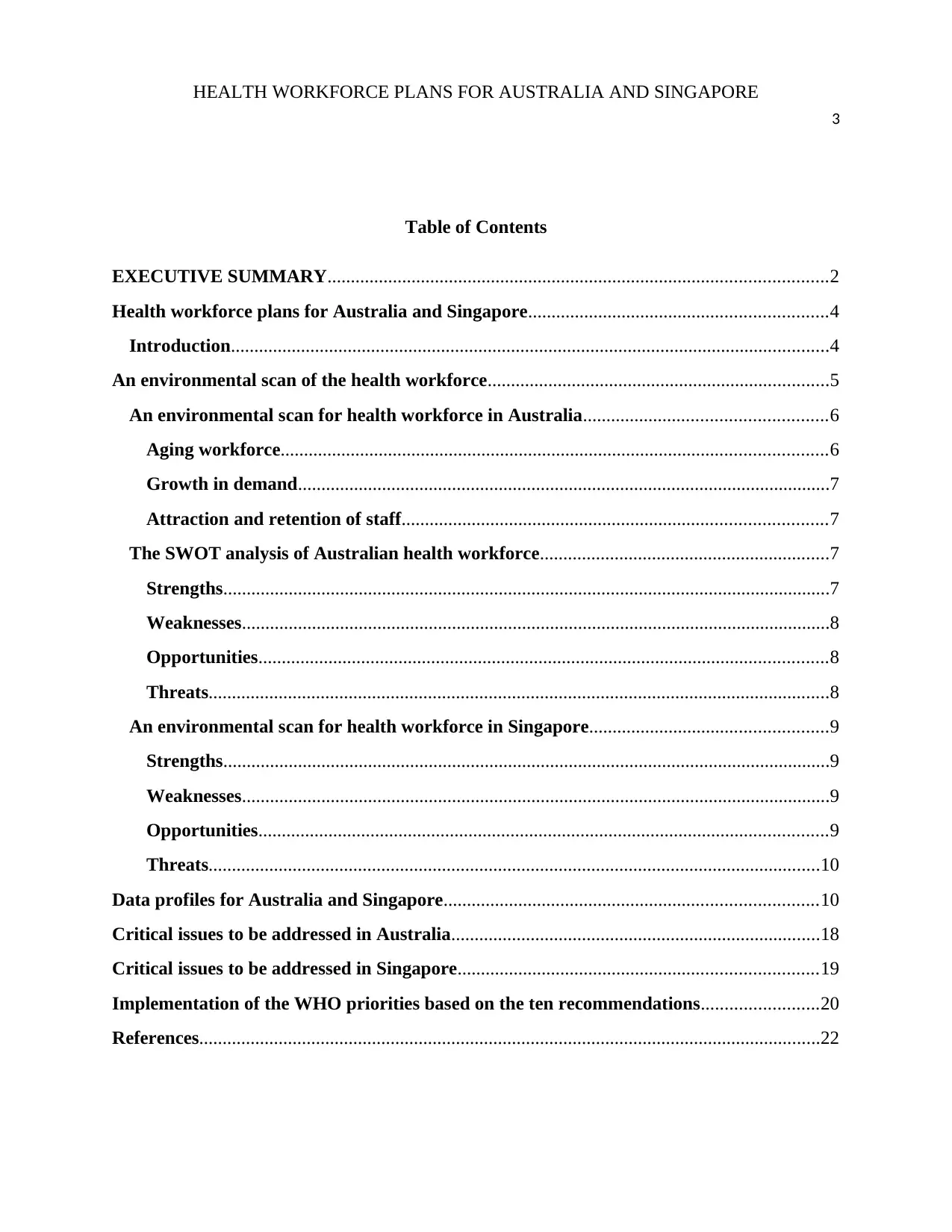
HEALTH WORKFORCE PLANS FOR AUSTRALIA AND SINGAPORE
3
Table of Contents
EXECUTIVE SUMMARY...........................................................................................................2
Health workforce plans for Australia and Singapore................................................................4
Introduction................................................................................................................................4
An environmental scan of the health workforce.........................................................................5
An environmental scan for health workforce in Australia....................................................6
Aging workforce.....................................................................................................................6
Growth in demand..................................................................................................................7
Attraction and retention of staff...........................................................................................7
The SWOT analysis of Australian health workforce..............................................................7
Strengths..................................................................................................................................7
Weaknesses..............................................................................................................................8
Opportunities..........................................................................................................................8
Threats.....................................................................................................................................8
An environmental scan for health workforce in Singapore...................................................9
Strengths..................................................................................................................................9
Weaknesses..............................................................................................................................9
Opportunities..........................................................................................................................9
Threats...................................................................................................................................10
Data profiles for Australia and Singapore................................................................................10
Critical issues to be addressed in Australia...............................................................................18
Critical issues to be addressed in Singapore.............................................................................19
Implementation of the WHO priorities based on the ten recommendations.........................20
References.....................................................................................................................................22
3
Table of Contents
EXECUTIVE SUMMARY...........................................................................................................2
Health workforce plans for Australia and Singapore................................................................4
Introduction................................................................................................................................4
An environmental scan of the health workforce.........................................................................5
An environmental scan for health workforce in Australia....................................................6
Aging workforce.....................................................................................................................6
Growth in demand..................................................................................................................7
Attraction and retention of staff...........................................................................................7
The SWOT analysis of Australian health workforce..............................................................7
Strengths..................................................................................................................................7
Weaknesses..............................................................................................................................8
Opportunities..........................................................................................................................8
Threats.....................................................................................................................................8
An environmental scan for health workforce in Singapore...................................................9
Strengths..................................................................................................................................9
Weaknesses..............................................................................................................................9
Opportunities..........................................................................................................................9
Threats...................................................................................................................................10
Data profiles for Australia and Singapore................................................................................10
Critical issues to be addressed in Australia...............................................................................18
Critical issues to be addressed in Singapore.............................................................................19
Implementation of the WHO priorities based on the ten recommendations.........................20
References.....................................................................................................................................22
⊘ This is a preview!⊘
Do you want full access?
Subscribe today to unlock all pages.

Trusted by 1+ million students worldwide
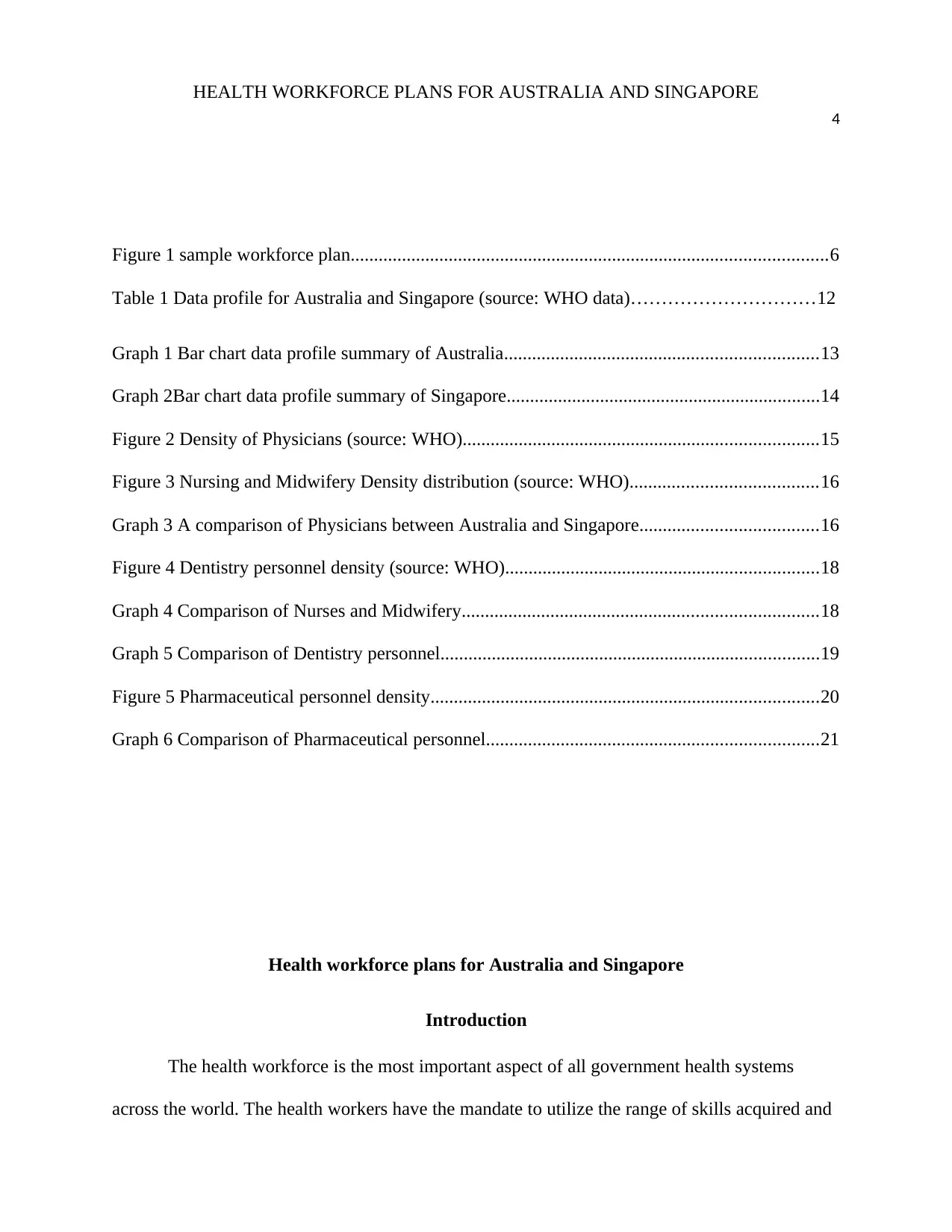
HEALTH WORKFORCE PLANS FOR AUSTRALIA AND SINGAPORE
4
Figure 1 sample workforce plan......................................................................................................6
Table 1 Data profile for Australia and Singapore (source: WHO data)…………………………12
Graph 1 Bar chart data profile summary of Australia...................................................................13
Graph 2Bar chart data profile summary of Singapore...................................................................14
Figure 2 Density of Physicians (source: WHO)............................................................................15
Figure 3 Nursing and Midwifery Density distribution (source: WHO)........................................16
Graph 3 A comparison of Physicians between Australia and Singapore......................................16
Figure 4 Dentistry personnel density (source: WHO)...................................................................18
Graph 4 Comparison of Nurses and Midwifery............................................................................18
Graph 5 Comparison of Dentistry personnel.................................................................................19
Figure 5 Pharmaceutical personnel density...................................................................................20
Graph 6 Comparison of Pharmaceutical personnel.......................................................................21
Health workforce plans for Australia and Singapore
Introduction
The health workforce is the most important aspect of all government health systems
across the world. The health workers have the mandate to utilize the range of skills acquired and
4
Figure 1 sample workforce plan......................................................................................................6
Table 1 Data profile for Australia and Singapore (source: WHO data)…………………………12
Graph 1 Bar chart data profile summary of Australia...................................................................13
Graph 2Bar chart data profile summary of Singapore...................................................................14
Figure 2 Density of Physicians (source: WHO)............................................................................15
Figure 3 Nursing and Midwifery Density distribution (source: WHO)........................................16
Graph 3 A comparison of Physicians between Australia and Singapore......................................16
Figure 4 Dentistry personnel density (source: WHO)...................................................................18
Graph 4 Comparison of Nurses and Midwifery............................................................................18
Graph 5 Comparison of Dentistry personnel.................................................................................19
Figure 5 Pharmaceutical personnel density...................................................................................20
Graph 6 Comparison of Pharmaceutical personnel.......................................................................21
Health workforce plans for Australia and Singapore
Introduction
The health workforce is the most important aspect of all government health systems
across the world. The health workers have the mandate to utilize the range of skills acquired and
Paraphrase This Document
Need a fresh take? Get an instant paraphrase of this document with our AI Paraphraser
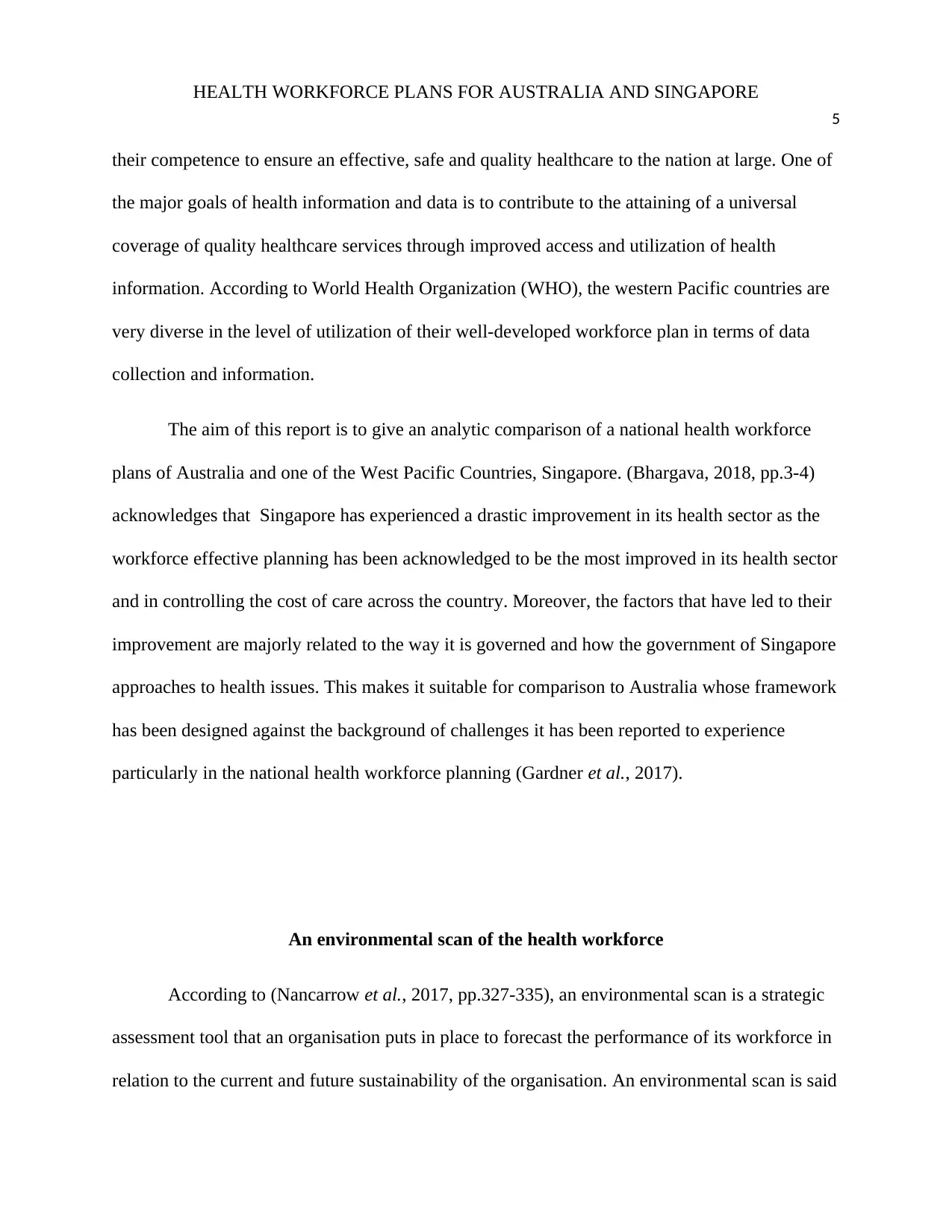
HEALTH WORKFORCE PLANS FOR AUSTRALIA AND SINGAPORE
5
their competence to ensure an effective, safe and quality healthcare to the nation at large. One of
the major goals of health information and data is to contribute to the attaining of a universal
coverage of quality healthcare services through improved access and utilization of health
information. According to World Health Organization (WHO), the western Pacific countries are
very diverse in the level of utilization of their well-developed workforce plan in terms of data
collection and information.
The aim of this report is to give an analytic comparison of a national health workforce
plans of Australia and one of the West Pacific Countries, Singapore. (Bhargava, 2018, pp.3-4)
acknowledges that Singapore has experienced a drastic improvement in its health sector as the
workforce effective planning has been acknowledged to be the most improved in its health sector
and in controlling the cost of care across the country. Moreover, the factors that have led to their
improvement are majorly related to the way it is governed and how the government of Singapore
approaches to health issues. This makes it suitable for comparison to Australia whose framework
has been designed against the background of challenges it has been reported to experience
particularly in the national health workforce planning (Gardner et al., 2017).
An environmental scan of the health workforce
According to (Nancarrow et al., 2017, pp.327-335), an environmental scan is a strategic
assessment tool that an organisation puts in place to forecast the performance of its workforce in
relation to the current and future sustainability of the organisation. An environmental scan is said
5
their competence to ensure an effective, safe and quality healthcare to the nation at large. One of
the major goals of health information and data is to contribute to the attaining of a universal
coverage of quality healthcare services through improved access and utilization of health
information. According to World Health Organization (WHO), the western Pacific countries are
very diverse in the level of utilization of their well-developed workforce plan in terms of data
collection and information.
The aim of this report is to give an analytic comparison of a national health workforce
plans of Australia and one of the West Pacific Countries, Singapore. (Bhargava, 2018, pp.3-4)
acknowledges that Singapore has experienced a drastic improvement in its health sector as the
workforce effective planning has been acknowledged to be the most improved in its health sector
and in controlling the cost of care across the country. Moreover, the factors that have led to their
improvement are majorly related to the way it is governed and how the government of Singapore
approaches to health issues. This makes it suitable for comparison to Australia whose framework
has been designed against the background of challenges it has been reported to experience
particularly in the national health workforce planning (Gardner et al., 2017).
An environmental scan of the health workforce
According to (Nancarrow et al., 2017, pp.327-335), an environmental scan is a strategic
assessment tool that an organisation puts in place to forecast the performance of its workforce in
relation to the current and future sustainability of the organisation. An environmental scan is said
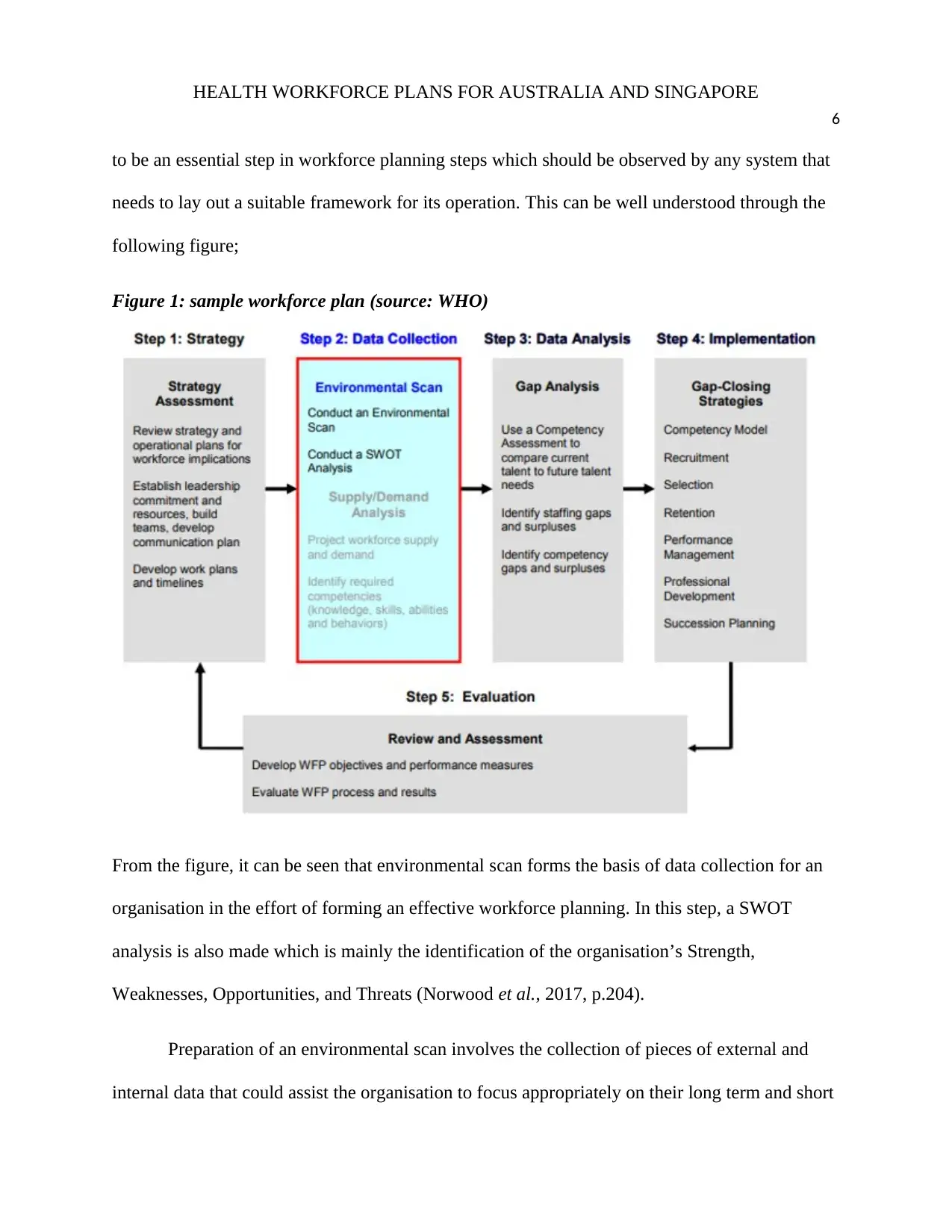
HEALTH WORKFORCE PLANS FOR AUSTRALIA AND SINGAPORE
6
to be an essential step in workforce planning steps which should be observed by any system that
needs to lay out a suitable framework for its operation. This can be well understood through the
following figure;
Figure 1: sample workforce plan (source: WHO)
From the figure, it can be seen that environmental scan forms the basis of data collection for an
organisation in the effort of forming an effective workforce planning. In this step, a SWOT
analysis is also made which is mainly the identification of the organisation’s Strength,
Weaknesses, Opportunities, and Threats (Norwood et al., 2017, p.204).
Preparation of an environmental scan involves the collection of pieces of external and
internal data that could assist the organisation to focus appropriately on their long term and short
6
to be an essential step in workforce planning steps which should be observed by any system that
needs to lay out a suitable framework for its operation. This can be well understood through the
following figure;
Figure 1: sample workforce plan (source: WHO)
From the figure, it can be seen that environmental scan forms the basis of data collection for an
organisation in the effort of forming an effective workforce planning. In this step, a SWOT
analysis is also made which is mainly the identification of the organisation’s Strength,
Weaknesses, Opportunities, and Threats (Norwood et al., 2017, p.204).
Preparation of an environmental scan involves the collection of pieces of external and
internal data that could assist the organisation to focus appropriately on their long term and short
⊘ This is a preview!⊘
Do you want full access?
Subscribe today to unlock all pages.

Trusted by 1+ million students worldwide
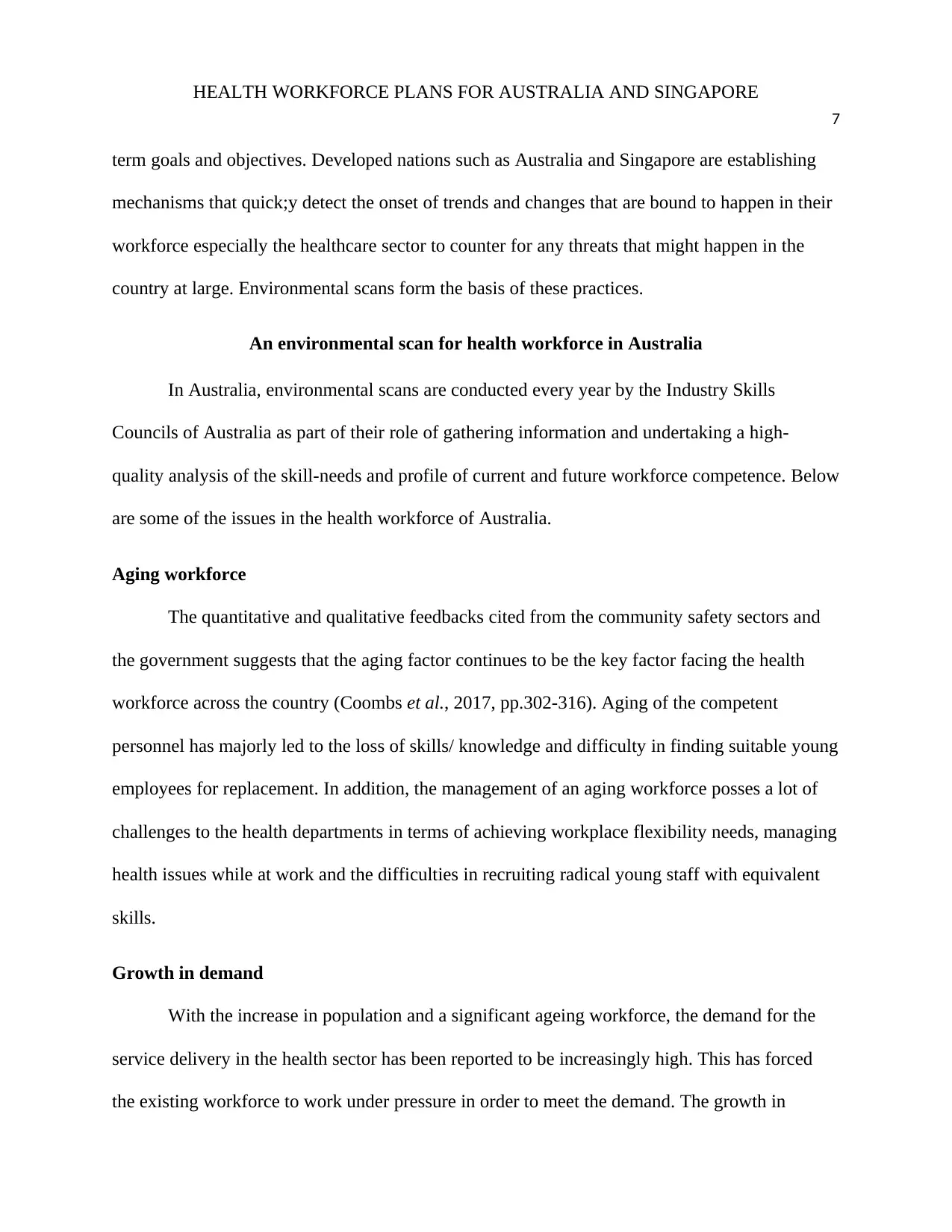
HEALTH WORKFORCE PLANS FOR AUSTRALIA AND SINGAPORE
7
term goals and objectives. Developed nations such as Australia and Singapore are establishing
mechanisms that quick;y detect the onset of trends and changes that are bound to happen in their
workforce especially the healthcare sector to counter for any threats that might happen in the
country at large. Environmental scans form the basis of these practices.
An environmental scan for health workforce in Australia
In Australia, environmental scans are conducted every year by the Industry Skills
Councils of Australia as part of their role of gathering information and undertaking a high-
quality analysis of the skill-needs and profile of current and future workforce competence. Below
are some of the issues in the health workforce of Australia.
Aging workforce
The quantitative and qualitative feedbacks cited from the community safety sectors and
the government suggests that the aging factor continues to be the key factor facing the health
workforce across the country (Coombs et al., 2017, pp.302-316). Aging of the competent
personnel has majorly led to the loss of skills/ knowledge and difficulty in finding suitable young
employees for replacement. In addition, the management of an aging workforce posses a lot of
challenges to the health departments in terms of achieving workplace flexibility needs, managing
health issues while at work and the difficulties in recruiting radical young staff with equivalent
skills.
Growth in demand
With the increase in population and a significant ageing workforce, the demand for the
service delivery in the health sector has been reported to be increasingly high. This has forced
the existing workforce to work under pressure in order to meet the demand. The growth in
7
term goals and objectives. Developed nations such as Australia and Singapore are establishing
mechanisms that quick;y detect the onset of trends and changes that are bound to happen in their
workforce especially the healthcare sector to counter for any threats that might happen in the
country at large. Environmental scans form the basis of these practices.
An environmental scan for health workforce in Australia
In Australia, environmental scans are conducted every year by the Industry Skills
Councils of Australia as part of their role of gathering information and undertaking a high-
quality analysis of the skill-needs and profile of current and future workforce competence. Below
are some of the issues in the health workforce of Australia.
Aging workforce
The quantitative and qualitative feedbacks cited from the community safety sectors and
the government suggests that the aging factor continues to be the key factor facing the health
workforce across the country (Coombs et al., 2017, pp.302-316). Aging of the competent
personnel has majorly led to the loss of skills/ knowledge and difficulty in finding suitable young
employees for replacement. In addition, the management of an aging workforce posses a lot of
challenges to the health departments in terms of achieving workplace flexibility needs, managing
health issues while at work and the difficulties in recruiting radical young staff with equivalent
skills.
Growth in demand
With the increase in population and a significant ageing workforce, the demand for the
service delivery in the health sector has been reported to be increasingly high. This has forced
the existing workforce to work under pressure in order to meet the demand. The growth in
Paraphrase This Document
Need a fresh take? Get an instant paraphrase of this document with our AI Paraphraser
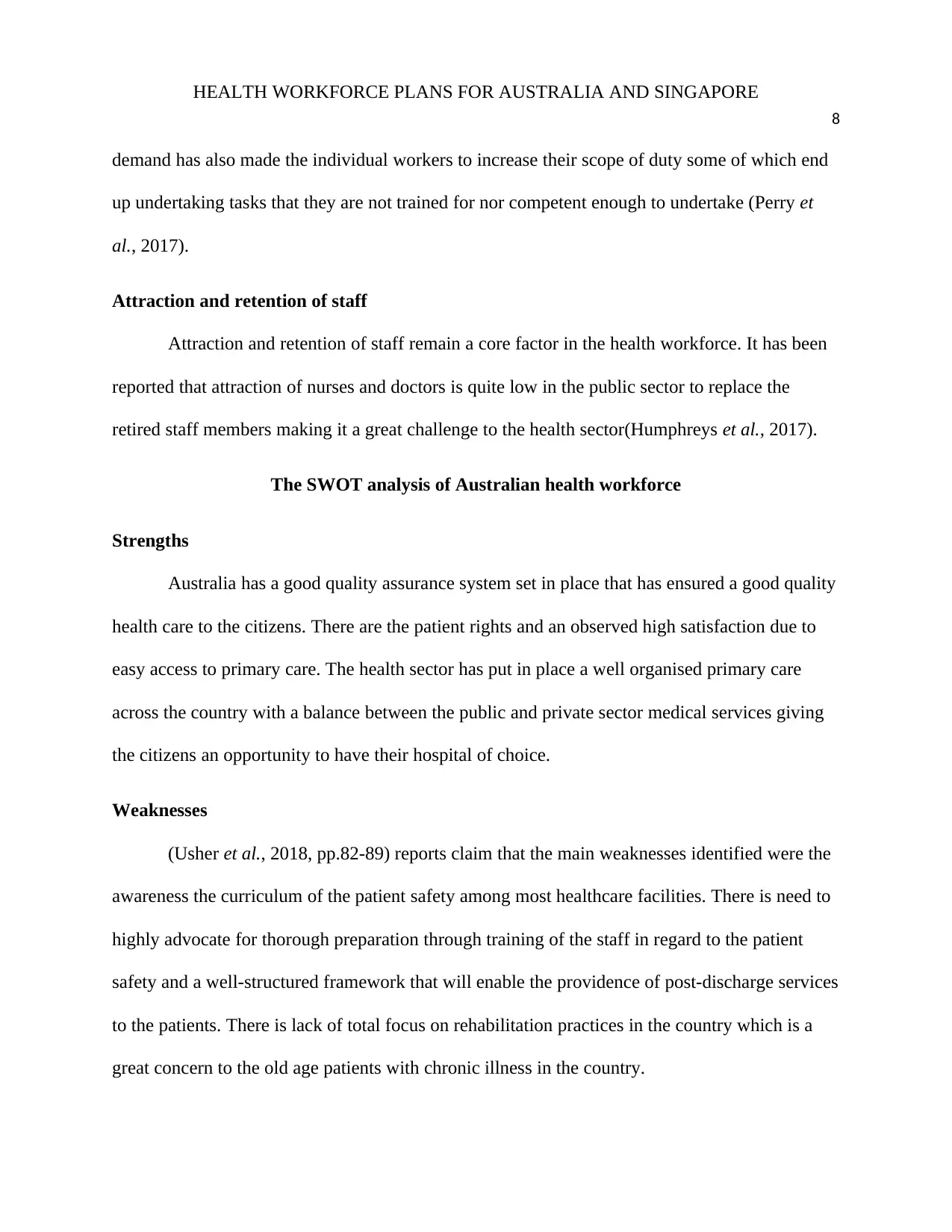
HEALTH WORKFORCE PLANS FOR AUSTRALIA AND SINGAPORE
8
demand has also made the individual workers to increase their scope of duty some of which end
up undertaking tasks that they are not trained for nor competent enough to undertake (Perry et
al., 2017).
Attraction and retention of staff
Attraction and retention of staff remain a core factor in the health workforce. It has been
reported that attraction of nurses and doctors is quite low in the public sector to replace the
retired staff members making it a great challenge to the health sector(Humphreys et al., 2017).
The SWOT analysis of Australian health workforce
Strengths
Australia has a good quality assurance system set in place that has ensured a good quality
health care to the citizens. There are the patient rights and an observed high satisfaction due to
easy access to primary care. The health sector has put in place a well organised primary care
across the country with a balance between the public and private sector medical services giving
the citizens an opportunity to have their hospital of choice.
Weaknesses
(Usher et al., 2018, pp.82-89) reports claim that the main weaknesses identified were the
awareness the curriculum of the patient safety among most healthcare facilities. There is need to
highly advocate for thorough preparation through training of the staff in regard to the patient
safety and a well-structured framework that will enable the providence of post-discharge services
to the patients. There is lack of total focus on rehabilitation practices in the country which is a
great concern to the old age patients with chronic illness in the country.
8
demand has also made the individual workers to increase their scope of duty some of which end
up undertaking tasks that they are not trained for nor competent enough to undertake (Perry et
al., 2017).
Attraction and retention of staff
Attraction and retention of staff remain a core factor in the health workforce. It has been
reported that attraction of nurses and doctors is quite low in the public sector to replace the
retired staff members making it a great challenge to the health sector(Humphreys et al., 2017).
The SWOT analysis of Australian health workforce
Strengths
Australia has a good quality assurance system set in place that has ensured a good quality
health care to the citizens. There are the patient rights and an observed high satisfaction due to
easy access to primary care. The health sector has put in place a well organised primary care
across the country with a balance between the public and private sector medical services giving
the citizens an opportunity to have their hospital of choice.
Weaknesses
(Usher et al., 2018, pp.82-89) reports claim that the main weaknesses identified were the
awareness the curriculum of the patient safety among most healthcare facilities. There is need to
highly advocate for thorough preparation through training of the staff in regard to the patient
safety and a well-structured framework that will enable the providence of post-discharge services
to the patients. There is lack of total focus on rehabilitation practices in the country which is a
great concern to the old age patients with chronic illness in the country.
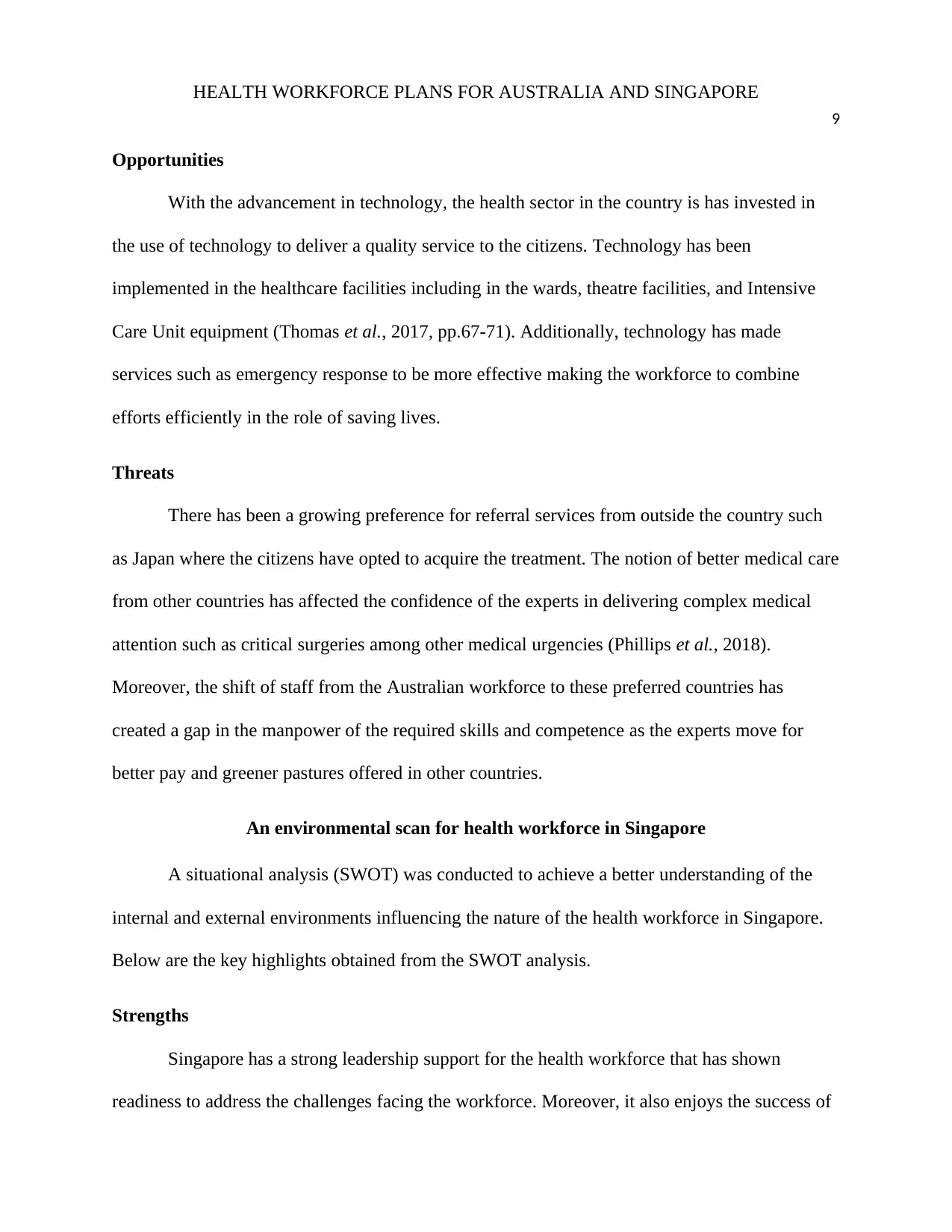
HEALTH WORKFORCE PLANS FOR AUSTRALIA AND SINGAPORE
9
Opportunities
With the advancement in technology, the health sector in the country is has invested in
the use of technology to deliver a quality service to the citizens. Technology has been
implemented in the healthcare facilities including in the wards, theatre facilities, and Intensive
Care Unit equipment (Thomas et al., 2017, pp.67-71). Additionally, technology has made
services such as emergency response to be more effective making the workforce to combine
efforts efficiently in the role of saving lives.
Threats
There has been a growing preference for referral services from outside the country such
as Japan where the citizens have opted to acquire the treatment. The notion of better medical care
from other countries has affected the confidence of the experts in delivering complex medical
attention such as critical surgeries among other medical urgencies (Phillips et al., 2018).
Moreover, the shift of staff from the Australian workforce to these preferred countries has
created a gap in the manpower of the required skills and competence as the experts move for
better pay and greener pastures offered in other countries.
An environmental scan for health workforce in Singapore
A situational analysis (SWOT) was conducted to achieve a better understanding of the
internal and external environments influencing the nature of the health workforce in Singapore.
Below are the key highlights obtained from the SWOT analysis.
Strengths
Singapore has a strong leadership support for the health workforce that has shown
readiness to address the challenges facing the workforce. Moreover, it also enjoys the success of
9
Opportunities
With the advancement in technology, the health sector in the country is has invested in
the use of technology to deliver a quality service to the citizens. Technology has been
implemented in the healthcare facilities including in the wards, theatre facilities, and Intensive
Care Unit equipment (Thomas et al., 2017, pp.67-71). Additionally, technology has made
services such as emergency response to be more effective making the workforce to combine
efforts efficiently in the role of saving lives.
Threats
There has been a growing preference for referral services from outside the country such
as Japan where the citizens have opted to acquire the treatment. The notion of better medical care
from other countries has affected the confidence of the experts in delivering complex medical
attention such as critical surgeries among other medical urgencies (Phillips et al., 2018).
Moreover, the shift of staff from the Australian workforce to these preferred countries has
created a gap in the manpower of the required skills and competence as the experts move for
better pay and greener pastures offered in other countries.
An environmental scan for health workforce in Singapore
A situational analysis (SWOT) was conducted to achieve a better understanding of the
internal and external environments influencing the nature of the health workforce in Singapore.
Below are the key highlights obtained from the SWOT analysis.
Strengths
Singapore has a strong leadership support for the health workforce that has shown
readiness to address the challenges facing the workforce. Moreover, it also enjoys the success of
⊘ This is a preview!⊘
Do you want full access?
Subscribe today to unlock all pages.

Trusted by 1+ million students worldwide
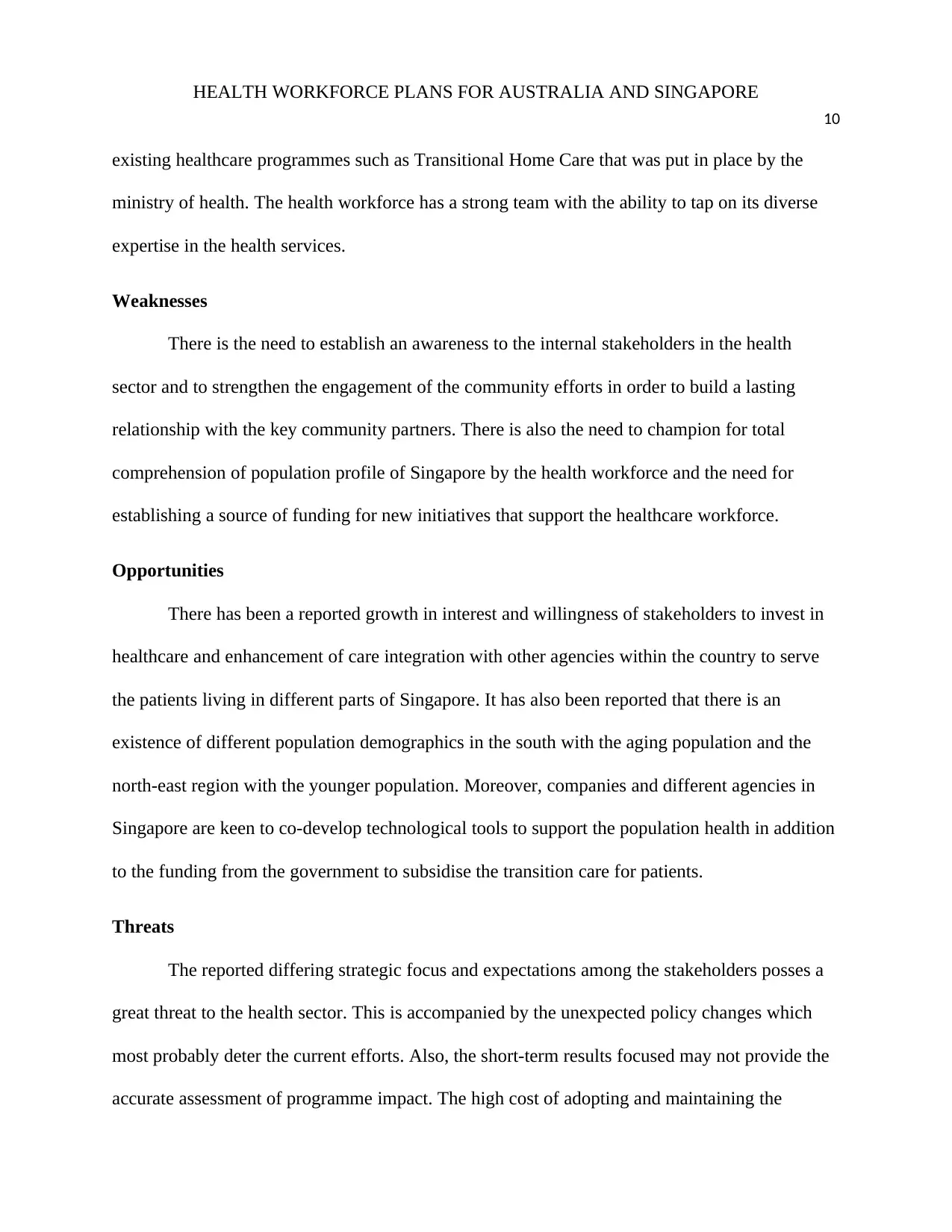
HEALTH WORKFORCE PLANS FOR AUSTRALIA AND SINGAPORE
10
existing healthcare programmes such as Transitional Home Care that was put in place by the
ministry of health. The health workforce has a strong team with the ability to tap on its diverse
expertise in the health services.
Weaknesses
There is the need to establish an awareness to the internal stakeholders in the health
sector and to strengthen the engagement of the community efforts in order to build a lasting
relationship with the key community partners. There is also the need to champion for total
comprehension of population profile of Singapore by the health workforce and the need for
establishing a source of funding for new initiatives that support the healthcare workforce.
Opportunities
There has been a reported growth in interest and willingness of stakeholders to invest in
healthcare and enhancement of care integration with other agencies within the country to serve
the patients living in different parts of Singapore. It has also been reported that there is an
existence of different population demographics in the south with the aging population and the
north-east region with the younger population. Moreover, companies and different agencies in
Singapore are keen to co-develop technological tools to support the population health in addition
to the funding from the government to subsidise the transition care for patients.
Threats
The reported differing strategic focus and expectations among the stakeholders posses a
great threat to the health sector. This is accompanied by the unexpected policy changes which
most probably deter the current efforts. Also, the short-term results focused may not provide the
accurate assessment of programme impact. The high cost of adopting and maintaining the
10
existing healthcare programmes such as Transitional Home Care that was put in place by the
ministry of health. The health workforce has a strong team with the ability to tap on its diverse
expertise in the health services.
Weaknesses
There is the need to establish an awareness to the internal stakeholders in the health
sector and to strengthen the engagement of the community efforts in order to build a lasting
relationship with the key community partners. There is also the need to champion for total
comprehension of population profile of Singapore by the health workforce and the need for
establishing a source of funding for new initiatives that support the healthcare workforce.
Opportunities
There has been a reported growth in interest and willingness of stakeholders to invest in
healthcare and enhancement of care integration with other agencies within the country to serve
the patients living in different parts of Singapore. It has also been reported that there is an
existence of different population demographics in the south with the aging population and the
north-east region with the younger population. Moreover, companies and different agencies in
Singapore are keen to co-develop technological tools to support the population health in addition
to the funding from the government to subsidise the transition care for patients.
Threats
The reported differing strategic focus and expectations among the stakeholders posses a
great threat to the health sector. This is accompanied by the unexpected policy changes which
most probably deter the current efforts. Also, the short-term results focused may not provide the
accurate assessment of programme impact. The high cost of adopting and maintaining the
Paraphrase This Document
Need a fresh take? Get an instant paraphrase of this document with our AI Paraphraser
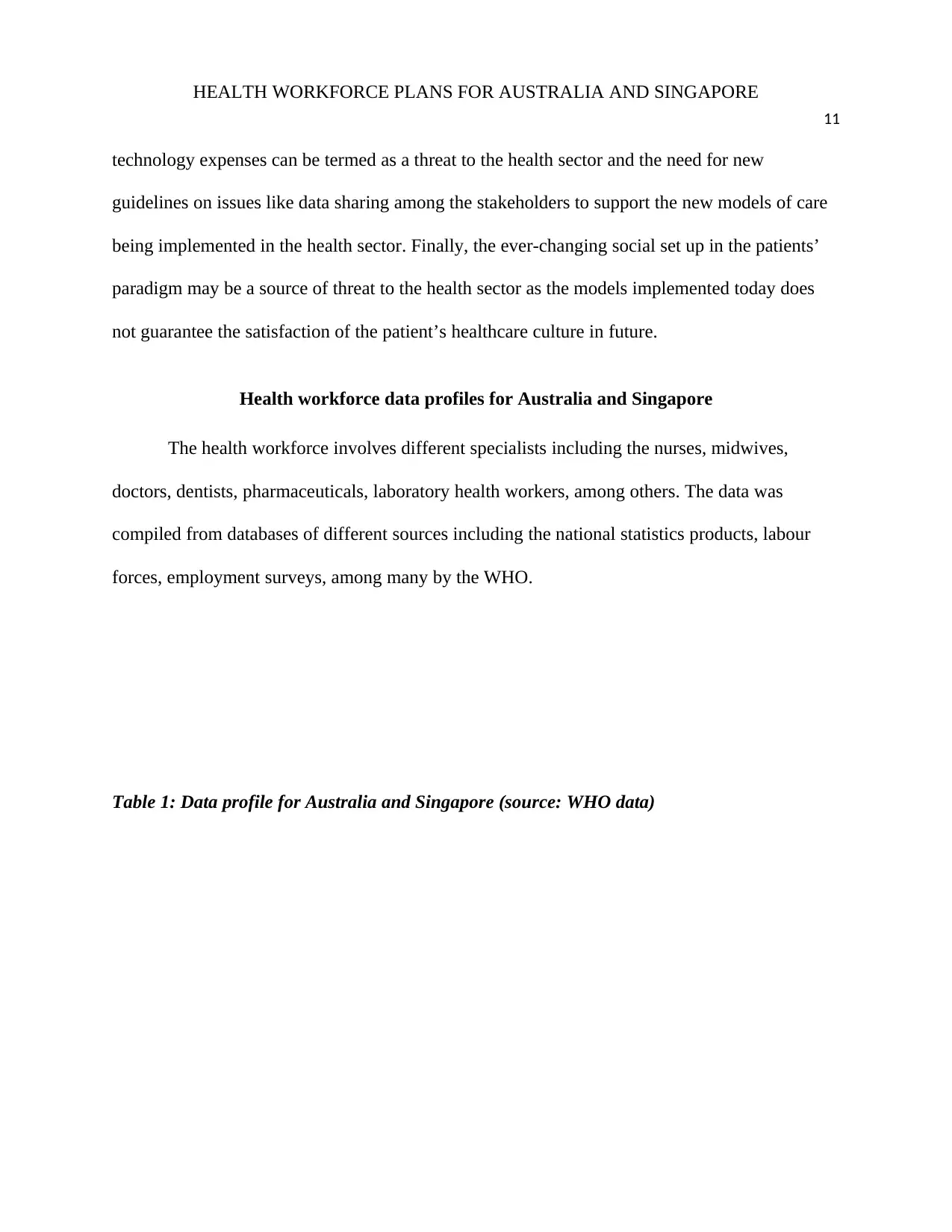
HEALTH WORKFORCE PLANS FOR AUSTRALIA AND SINGAPORE
11
technology expenses can be termed as a threat to the health sector and the need for new
guidelines on issues like data sharing among the stakeholders to support the new models of care
being implemented in the health sector. Finally, the ever-changing social set up in the patients’
paradigm may be a source of threat to the health sector as the models implemented today does
not guarantee the satisfaction of the patient’s healthcare culture in future.
Health workforce data profiles for Australia and Singapore
The health workforce involves different specialists including the nurses, midwives,
doctors, dentists, pharmaceuticals, laboratory health workers, among others. The data was
compiled from databases of different sources including the national statistics products, labour
forces, employment surveys, among many by the WHO.
Table 1: Data profile for Australia and Singapore (source: WHO data)
11
technology expenses can be termed as a threat to the health sector and the need for new
guidelines on issues like data sharing among the stakeholders to support the new models of care
being implemented in the health sector. Finally, the ever-changing social set up in the patients’
paradigm may be a source of threat to the health sector as the models implemented today does
not guarantee the satisfaction of the patient’s healthcare culture in future.
Health workforce data profiles for Australia and Singapore
The health workforce involves different specialists including the nurses, midwives,
doctors, dentists, pharmaceuticals, laboratory health workers, among others. The data was
compiled from databases of different sources including the national statistics products, labour
forces, employment surveys, among many by the WHO.
Table 1: Data profile for Australia and Singapore (source: WHO data)
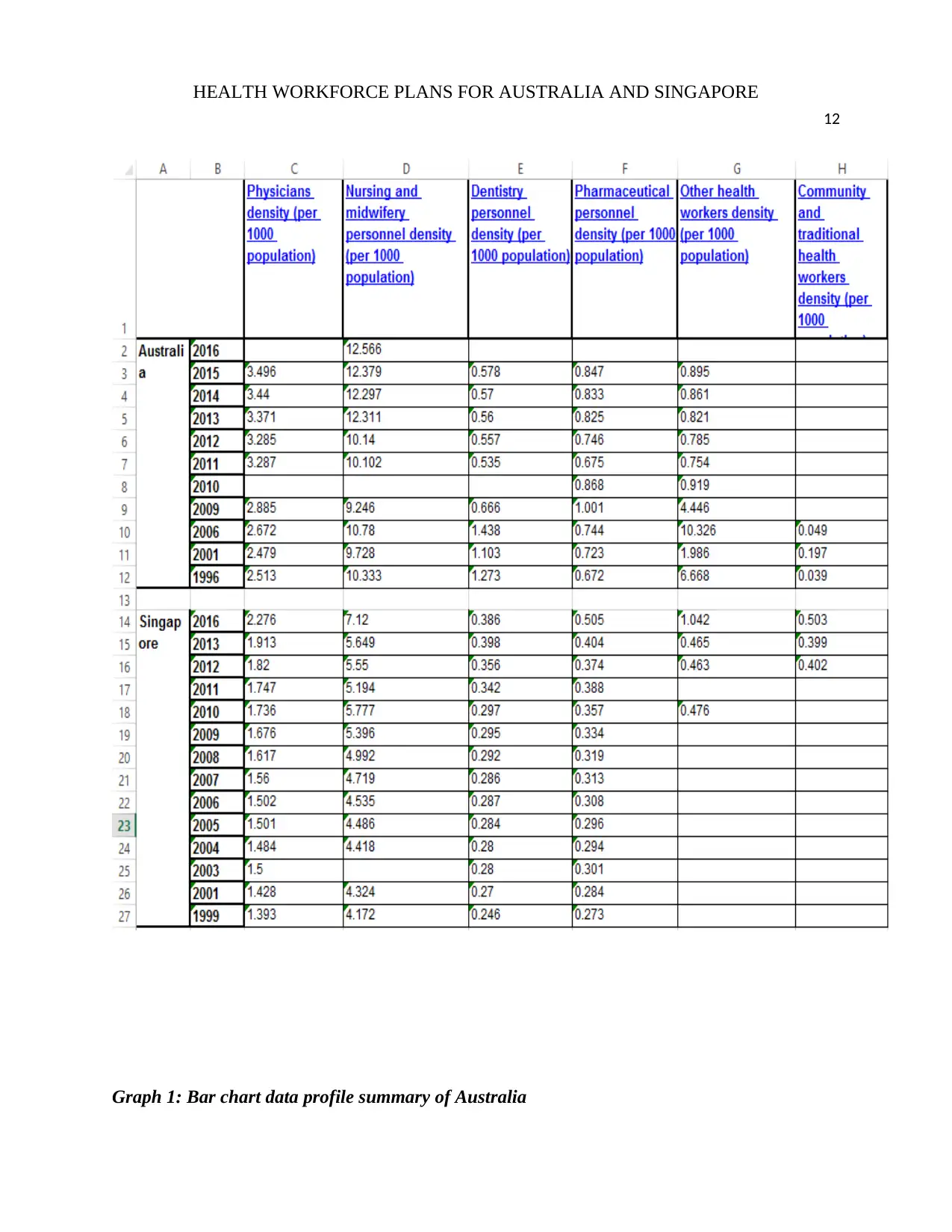
HEALTH WORKFORCE PLANS FOR AUSTRALIA AND SINGAPORE
12
Graph 1: Bar chart data profile summary of Australia
12
Graph 1: Bar chart data profile summary of Australia
⊘ This is a preview!⊘
Do you want full access?
Subscribe today to unlock all pages.

Trusted by 1+ million students worldwide
1 out of 26
Related Documents
Your All-in-One AI-Powered Toolkit for Academic Success.
+13062052269
info@desklib.com
Available 24*7 on WhatsApp / Email
![[object Object]](/_next/static/media/star-bottom.7253800d.svg)
Unlock your academic potential
Copyright © 2020–2025 A2Z Services. All Rights Reserved. Developed and managed by ZUCOL.




